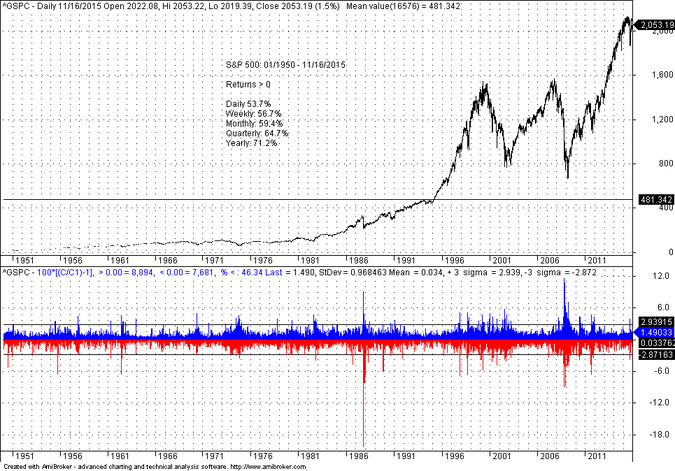Some charlatans pose as fundamental, technical, or even quant analysts. A frequent narrative these charlatans use involves a rise in stocks, and they justify it with some trivial analysis. Instead, they should be telling us when the market will fall, not when it will rise. Then, we will know if they know anything. Read below why.
The stock market has a strong upward bias, as an analysis of the data shows. Since 1950 and in daily data, the S&P 500 has been up 53.7% of the time. Weekly, the index has gained 56.7% of the time. Then, monthly, the index is up 59.4% of the time.
As the timeframe increases, so does the success rate. Quarterly, the S&P 500 has gained 64.8% of the time, and yearly, 71.2% of the time.
Below is a chart for the daily timeframe with data for all other timeframes mentioned:
As a result, the likelihood that a charlatan will, on average, be correct if they consistently predict that the market will rise over a given period while using some superficial but dubious analysis is as follows:
Odds = p/(1-p)
where p is the probability of success.
The table below shows data for the various time frames mentioned:
| Timeframe | Success rate | Odds in favor |
| Daily | 53.7% | 1.16:1 |
| Weekly | 54.7% | 1.30:1 |
| Monthly | 59.4% | 1:46:1 |
| Quarterly | 64.7% | 1.83:1 |
| Yearly | 71.2% | 2.47:1 |
It is clear from the above table that, for the stock market, the odds of a gain in any timeframe listed are in favor of forecasts made by some charlatans. We are not talking only about charlatans who pose as technical analysts in front of a crowd of uninformed individuals who never take the time to do a simple statistical analysis of this sort. We are also talking about highly paid professional analysts who, every quarter or year, claim that the market will go up when they know the odds are overwhelmingly in their favor.
Therefore, if the odds are in favor of up moves in these timeframes, we can only judge the abilities of an analyst when there is a solid track record of correctly forecasting down moves where the odds are against him. I do not need anyone to tell me that the market will go up next month, or next year because I know that the probability of that is higher. I need someone to tell me when to protect my capital by selling and then taking advantage of the longer-term bias by buying at lower prices. This is the key to stock market investing success. I do not see many analysts being successful in doing this in the long term. Some, who in the past succeeded in forecasting a market crash, failed miserably with successive trials. The market can fool even the smartest analyst. This is one reason that the market has survived for so long and has reached new highs, while some analysts have changed professions after reaching new lows.
The conclusion from the above analysis is that when you hear an analyst claiming that the market will go up next month, next quarter, or next year, and presents for that some trivial explanation that is not based on sound statistics or a validated model, then he may be a charlatan that tries to build a carrier by taking advantage of the structural upward bias in the stock market.
Technical and quantitative analysis of major stock indexes and popular ETFs is included in our weekly Premium Reports. Market signals for position traders are offered by our premium Market Signals service
If you found this article interesting, you may follow this blog via RSS or Email, or on Twitter









